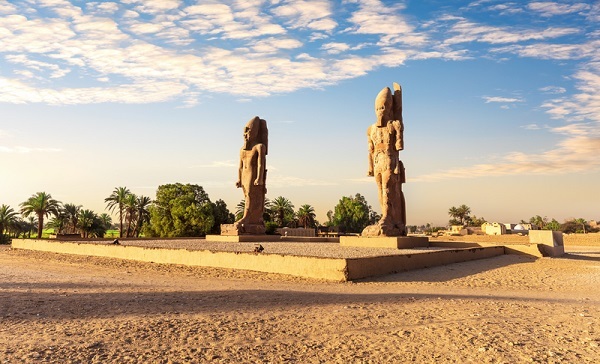

The Pharaohs of ancient Egypt were not only powerful rulers, but also patrons of the arts. They commissioned a wide variety of art forms, including paintings, sculptures, and jewelry, as well as monumental structures such as temples, tombs, and pyramids. The art and architecture produced during the pharaonic period is considered some of the most impressive and well-preserved in the world.
Many works of art were used to convey religious and political messages, as well as to commemorate the pharaoh's reign. Many pharaohs were also buried with elaborate funerary artifacts, such as sarcophagi and canopic jars. The art and architecture of ancient Egypt continue to be admired and studied by people all over the world.
Pharaohs commissioned a wide variety of art forms, including paintings, sculptures, and jewelry, which were used to decorate the monumental structures they built.
They also sponsored the construction of monumental structures such as temples, tombs, and pyramids, which were decorated with intricate carvings and reliefs depicting religious and political themes.
Many pharaohs were also buried with elaborate funerary artifacts, such as sarcophagi, canopic jars, and other grave goods, which were decorated with intricate carvings, hieroglyphics and paintings. These funerary objects served not only as a representation of the deceased but also as a way of providing for the deceased in the afterlife.
The art produced during the pharaonic period was highly skilled and detailed, it was created by professional artists and artisans who were highly trained and respected in their field.
The art produced during the pharaonic period was not only limited to Egypt but also exported to other parts of the ancient world, reflecting the cultural and economic influence of Egypt during that time.

Colossal statues on the way to the Valley of Kings, Luxor, Egypt
Pharaohs commissioned many monumental structures, including temples, tombs, and pyramids, which were built to last for centuries.
The most famous of these is the Great Pyramid of Giza, built for the pharaoh Khufu, it is considered one of the Seven Wonders of the Ancient World and is still one of the most visited tourist sites today.
Other notable examples include the Temple of Amun at Karnak, which was one of the most important religious sites in ancient Egypt, the Valley of the Kings, where many pharaohs were buried in elaborate tombs, and the Temple of Ramses II at Abu Simbel, which was built to commemorate the pharaoh's victory in battle.
The pharaohs also built palace complexes and administrative buildings, which were used for government and administrative purposes. These structures were often adorned with intricate carvings, paintings, and reliefs depicting religious and political themes.
These monumental structures were not only built for religious and political reasons but also for practical purposes, such as providing storage for food, weapons and other essentials.
Pharaohs also built monumental statues, obelisks, and sphinxes, which were used to decorate temples, tombs, and public places. These statues were often adorned with hieroglyphics and inscriptions depicting religious and political messages.
Many of these monumental structures were built using advanced engineering techniques and required a large workforce of skilled labor, such as architects, engineers, masons, and artisans.
Pharaohs commissioned a wide variety of art forms, including paintings, sculptures, and jewelry, which were used to decorate their monumental structures and personal items
The art produced during the pharaonic period was not only limited to Egypt but also exported to other parts of the ancient world, reflecting the cultural and economic influence of Egypt during that time.
Many of the artworks produced during the pharaonic period were created using traditional techniques and materials, such as painting on papyrus or linen, and sculpting in stone or metal.
The art produced during the pharaonic period was not only for aesthetic purposes but also for religious and political reasons. The artworks were often used to convey religious beliefs, political propaganda, and to commemorate the pharaoh's reign.
The art produced during the pharaonic period was not only limited to commissioned works but also included everyday items such as pottery, jewelry, and amulets that were created by artisans for the general population.
In conclusion, the Pharaohs of ancient Egypt were powerful rulers who played a vital role in the development of art and architecture in their time. They commissioned a wide variety of art forms and monumental structures, many of which are still well-preserved today.
The art and architecture produced during the pharaonic period are considered some of the most impressive and well-preserved in the world. It continues to be a subject of admiration and study by people all over the world, giving us a glimpse into the rich culture and history of ancient Egypt. The legacy of the Pharaohs as patrons of the arts continues to inspire and fascinate people to this day.
Q1. How were the pharaohs depicted in the art commissioned by them?
Ans. Pharaohs were often depicted in a larger-than-life manner, with idealized features and a strong emphasis on their power and authority. They were often depicted in the traditional pharaonic regalia, and some of the statues had the pharaohs depicted as gods or god-kings.
Q2. Were the ancient Egyptians the only civilization to build monumental structures?
Ans. No, other ancient civilizations such as the Mayans and the Incas also built monumental structures, but the ancient Egyptians are considered to be particularly skilled in this area, and many of their monumental structures are still standing today and are considered architectural marvels.
Q3. What were the materials used in the construction of monumental structures in ancient Egypt?
Ans. The ancient Egyptians used a variety of materials in the construction of monumental structures, including limestone, sandstone, granite, and mud brick. They also used copper and bronze for decoration, and gold for the statues and coffins of pharaohs.